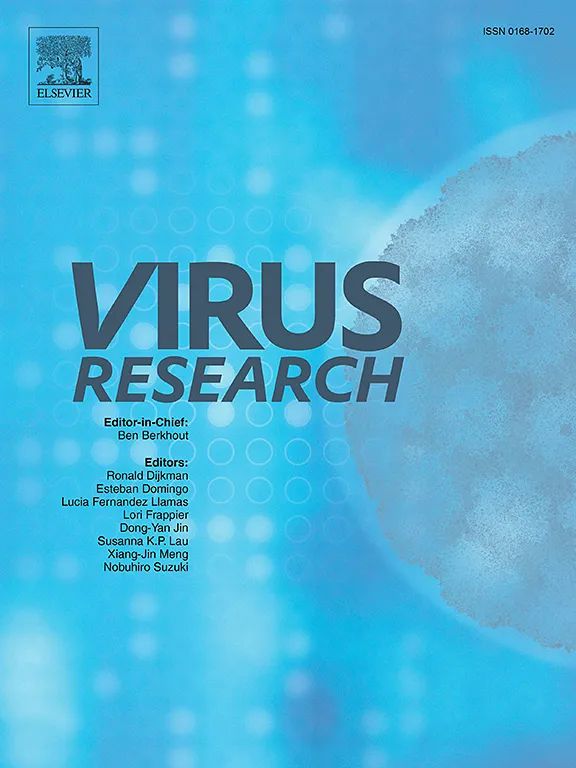Isolation, genomic analysis and biocontrol potential of bacteriophage SHY-Vp8 and its endolysin against Vibrio parahaemolyticus in shrimp aquaculture
IF 2.7
4区 医学
Q3 VIROLOGY
引用次数: 0
Abstract
Vibrio parahaemolyticus causes mass mortality in global penaeid shrimp aquaculture worldwide, with lethality exceeding 90 %, threatening global food security and economic sustainability. As alternatives to antibiotics, bacteriophages and their lytic enzymes offer target specificity, minimal resistance development, and high bactericidal efficiency. In this study, ten phages were isolated from Litopenaeus vannamei aquaculture ponds and adjacent estuarine areas using Vp499 as the host, which were isolated by our lab. Among these, phage SHY-Vp8 exhibited the highest titer against the host Vp499.Its optimal multiplicity of infection (MOI) was determined to be 1. Notably, SHY-Vp8 demonstrated a superior lytic capacity, with a high burst size (96 PFU/cell) and a short latent period (30 min), representing an 18–41 % improvement in lytic efficiency over previously reported Vibrio phages. Furthermore, it exhibited exceptional environmental resilience, tolerating temperatures up to 60 °C and a broad pH range (3–12), surpassing the stability thresholds of most known vibriophages. Whole-genome sequencing indicated a double-stranded DNA genome of 58,525 bp with 46.38 % GC content. Bioinformatic annotation identified 85 predicted genes, of which 31 encoded functionally characterized proteins. No tRNA or virulence genes were detected, demonstrating potential for therapeutic applications in aquaculture. Transmission electron microscopy confirmed an icosahedral capsid and a long non-contractile tail, classifying SHY-Vp8 within the Siphoviridae family. Notably, the gp59 gene was predicted to encode an endolysin. The gene was amplified cloned and expressed. The lytic activity of Lys59 exhibited a concentration-dependent increase, with peak activity observed at 50 μg/mL. Lys59 alone was capable of lysing Vp499 without the aid of EDTA; however, pretreatment with EDTA significantly enhanced its lytic efficiency. Results indicate that both SHY-Vp8 and Lys59 exhibit promising potential for controlling V. parahaemolyticus infections in L. vannamei, offering a novel and sustainable strategy for disease management in aquaculture—particularly in pond water treatment and seafood safety enhancement. These excellent in vitro activities and characteristics provide a solid foundation for further development of in vivo infection models and eco-friendly biocontrol agents.
对虾养殖中抗副溶血性弧菌噬菌体SHY-Vp8及其内溶素的分离、基因组分析及生物防治潜力
副溶血性弧菌在全球对虾养殖中造成大量死亡,致死率超过90%,威胁着全球粮食安全和经济可持续性。作为抗生素的替代品,噬菌体及其裂解酶具有靶向特异性、最小耐药性和高杀菌效率。本研究以Vp499为宿主,从凡纳滨对虾养殖池塘及邻近河口区分离得到10株噬菌体。其中,噬菌体hy - vp8对宿主Vp499的效价最高。确定其最优感染多重数(MOI)为1。值得注意的是,sh - vp8表现出优异的裂解能力,具有高爆发大小(96 PFU/细胞)和短潜伏期(30分钟),比先前报道的噬菌体弧菌的裂解效率提高了18-41%。此外,它还表现出了卓越的环境适应性,可耐受高达60°C的温度和广泛的pH范围(3-12),超过了大多数已知的噬菌体的稳定性阈值。全基因组测序结果显示,双链DNA基因组长度为58,525 bp, GC含量为46.38%。生物信息学注释鉴定出85个预测基因,其中31个编码功能特征蛋白。未检测到tRNA或毒力基因,表明其在水产养殖中的治疗应用潜力。透射电镜证实了一个二十面体衣壳和一个长而不可收缩的尾巴,将hy - vp8分类为Siphoviridae家族。值得注意的是,预测gp59基因编码一种内溶素。对该基因进行扩增、克隆和表达。Lys59的酶解活性呈浓度依赖性增加,在50 μg/mL时酶解活性最高。单独Lys59在没有EDTA的情况下也能裂解Vp499;EDTA预处理可显著提高其裂解效率。结果表明,SHY-Vp8和Lys59在控制凡纳梅副溶血性弧菌感染方面表现出良好的潜力,为水产养殖的疾病管理提供了一种新的可持续的策略,特别是在池塘水处理和提高海产品安全方面。这些良好的体外活性和特性为进一步开发体内感染模型和生态友好型生物防治剂提供了坚实的基础。
本文章由计算机程序翻译,如有差异,请以英文原文为准。
求助全文
约1分钟内获得全文
求助全文
来源期刊

Virus research
医学-病毒学
CiteScore
9.50
自引率
2.00%
发文量
239
审稿时长
43 days
期刊介绍:
Virus Research provides a means of fast publication for original papers on fundamental research in virology. Contributions on new developments concerning virus structure, replication, pathogenesis and evolution are encouraged. These include reports describing virus morphology, the function and antigenic analysis of virus structural components, virus genome structure and expression, analysis on virus replication processes, virus evolution in connection with antiviral interventions, effects of viruses on their host cells, particularly on the immune system, and the pathogenesis of virus infections, including oncogene activation and transduction.
 求助内容:
求助内容: 应助结果提醒方式:
应助结果提醒方式:


